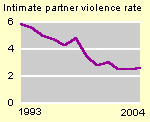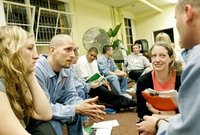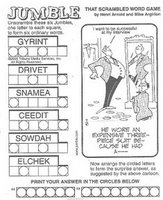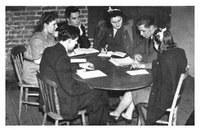 amidst new fears that u.s. crime rates are creeping up again, a great deal of evidence is accumulating to suggest that rates of rape and domestic violence are declining. a nice mclatchy-tribune piece reports the good news and offers some explanations for the drop.
amidst new fears that u.s. crime rates are creeping up again, a great deal of evidence is accumulating to suggest that rates of rape and domestic violence are declining. a nice mclatchy-tribune piece reports the good news and offers some explanations for the drop.
 the rake’s frank clancy takes up the issue of homicide this month, profiling and mapping all 60 minneapolis murders of 2006.
the rake’s frank clancy takes up the issue of homicide this month, profiling and mapping all 60 minneapolis murders of 2006.
 today’s eugene register-guard features a great front-page story on michelle inderbitzin’s inside-out prison exchange class. michelle brought 15 of her oregon state university students to join 15 oregon state penitentiary students for a course on crime, Justice, and public policy. michelle has been posting about the experience at publiccriminology throughout the quarter (including, for example, some memorable poetry from an inside student). yes, the start-up costs seem daunting — in terms of training, administration, permissions from deans and department chairs, travel, and security. for both inside students and outside students, however, i can’t imagine a more meaningful or powerful vehicle for teaching sociological criminology.
today’s eugene register-guard features a great front-page story on michelle inderbitzin’s inside-out prison exchange class. michelle brought 15 of her oregon state university students to join 15 oregon state penitentiary students for a course on crime, Justice, and public policy. michelle has been posting about the experience at publiccriminology throughout the quarter (including, for example, some memorable poetry from an inside student). yes, the start-up costs seem daunting — in terms of training, administration, permissions from deans and department chairs, travel, and security. for both inside students and outside students, however, i can’t imagine a more meaningful or powerful vehicle for teaching sociological criminology.
 i enjoy playing with anagrams, rearranging my kids’ names to fit some aspect of their personalities. for example, tor stanley uggen has the same letters as both gentle guy on star and let’s not anger guy. yeah, that sounds about right.
i enjoy playing with anagrams, rearranging my kids’ names to fit some aspect of their personalities. for example, tor stanley uggen has the same letters as both gentle guy on star and let’s not anger guy. yeah, that sounds about right.
it won’t surprise my students to learn that christopher uggen is actually code for hog-sprung heretic, and, given my minnesota biases, gopher guts enrich. wondering whether similar magic applies for the sociological criminologists i’ve been teaching in my delinquency class this year, i came up with the following variations without too much trouble. i’m self-censoring here, because some of the really funny ones seemed too cruel or unfair. i trust you can figure them out on your own, if so inclined.
let’s start with the classics. cesare lombroso whose criminal man connected primitive features with criminality in 1870, can be nicely anagramed into a slob score more. hmm. that rather nicely sums up atavistic theory, doesn’t it?
it is tougher to reconcile clifford shaw’s great work with his name. somehow scaffold whir or lads chow riff fail to capture the essence of social disorganization theory. how about my intellectual great grandfather, learning theorist edwin a. sutherland? it pains me to say so, but his critics might view he did learn, was nut or, more charitably, he did learn, aw nuts as all-too-appropriate alternative monikers.
speaking of professor sutherland’s critics, i couldn’t do much with social control theory’s travis hirschi (stir a rich shiv or chris ravish it) or anomie’s robert k. merton (torment broker and broken term rot are a little better). i had better luck with howard s. becker, who wrote a classic on marijuana use (saw herb rocked or sacred herb wok) and offered insightful critiques of mainstream sociology (bored whackers).
this week my students are reading meda chesney-lind on feminist criminology and juvenile Justice, so her new moniker (she demand nicely) might seem fitting. i couldn’t work the “q” into james q. wilson, but the brilliant conservative who wrote thinking about crime can otherwise be cruelly rearranged as jowls is mean.
ok, that’s where i draw the line. in fairness, i should also note that christopher uggen can be cruelly rearranged as pure hogs retching. though my personal anagrams can’t rival, say, mr. mojo risin’, i guess i’d prefer hog-sprung heretic to pure hogs retching.
 reuters reports that five of sixty-nine runway models are being kept off the catwalk at this week’s international designer show in madrid. evidently, their “ratio of body weight to height was so low it was deemed an unhealthy example to the public.”
reuters reports that five of sixty-nine runway models are being kept off the catwalk at this week’s international designer show in madrid. evidently, their “ratio of body weight to height was so low it was deemed an unhealthy example to the public.”
i’m no expert in the sociology of bodies, but i’m sure that patriarchy and control are part of the story. nevertheless, even male models are today pressured to drop to size zero. in recent years, the boy-waif look has apparently overtaken the buffed and angular male ideal.
i’ve written before about the body mass index and its flaws. this is partly personal (yes, at my current weight and height, i’m officially overweight) and partly scientific. there are far better ways to identify a healthy body weight than the b.m.i. for example, wrestlers have strong incentives to cut weight, so every minnesota grappler now sees a “certified skinfold technician” or undergoes a water displacement test to establish a minimum wrestling weight of at least seven percent body fat.
should the state or particular industries regulate the weight of a class of workers? i’m personally torn on this issue between libertarian (ain’t nobody’s business what i weigh) and communitarian (bad for society as well as bad for the models) impulses. that said, i’m all for placing sensible weight restrictions on children. the state and schools have an expansive license to intervene in the lives of juvenile models and wrestlers who have yet to reach the age of majority. and parental consent is no solution — many parents would sign anything if they thought it gave their kids an edge or a better shot at glory.
but this raises a bigger question, about which much has been written: why aren’t we associating physical beauty with adult bodies? super-skinny models lack the breasts, muscles, and curves associated with adulthood, so i can’t help but see the fashion industry as complicit in sexualizing kids and adolescents. or maybe it is just too darn difficult for high-end designers to deal with the curves and lumps of adult bodies. like placing a coat over the back of a chair, i suppose they can easily drape anything over a stick-like 5’11” 90-pounder.
as a runner and parent, i tend to emphasize exercise more than diet in discussions with my kids. one sees a marvelous diversity of body types at the average marathon, for example, but every finisher is defensibly “in shape.” i’m still trying to exercise my way out of the post-holiday interim pants, but i doubt that i’m in any immediate danger of hitting size zero.
 have you followed the recent stories regarding barack obama’s li’l habit? when i think smoking presidents, i call to mind images of fdr’s jaunty cigarette holder and general eisenhower inhaling four packs a day as he led the allies to victory in wwii.
have you followed the recent stories regarding barack obama’s li’l habit? when i think smoking presidents, i call to mind images of fdr’s jaunty cigarette holder and general eisenhower inhaling four packs a day as he led the allies to victory in wwii.
these days, things are different. why, mr. obama’s smoking may cause greater controversy than his teenage cocaine use. as maureen dowd suggests, smoking makes mr. obama “intriguingly imperfect.” as a non-smoker, i enjoy the image of the commander-in-chief sneaking out by the loading dock to suck down a heater between meetings.
just as former presidents clinton, ford, and reagan, mr. obama won’t be caught smoking around the cameras. joe biden would disapprove, i suppose, but i think most of us like to see a little fallibility in our presidential candidates.
while i would not approve of a glue-sniffing president or a chronic inebriate president, smoking has different connotations. i’d advise mr. obama to avoid the nicotine patches until after the election. a patch-wearing president seems weak and compromised relative to a smoking president. think about it: can you imagine winston churchill chewing nicorette? not during wartime, i’ll bet. nah, winnie went so far as to say, “My rule of life prescribed as an absolutely sacred rite smoking cigars and also the drinking of alcohol before, after and if need be during all meals and in the intervals between them.” here’s hoping our presidential candidates proceed with equal bravado.
 during my term as a piece of furniture consisting of a seat, legs, back, and often arms, designed to accommodate one person, i’m at least partially responsible for the content of faculty meetings. at the request of undergraduate advisor ann miller, we allocated fifteen minutes of monday’s meeting to a presentation on the use of mid-semester course evaluations.
during my term as a piece of furniture consisting of a seat, legs, back, and often arms, designed to accommodate one person, i’m at least partially responsible for the content of faculty meetings. at the request of undergraduate advisor ann miller, we allocated fifteen minutes of monday’s meeting to a presentation on the use of mid-semester course evaluations.
a representative from the minnversity’s center for teaching and learning introduced a model called student feedback through consensus. here’s how it works: a consultant comes to your class, asks students what’s working and what changes they would recommend, and meets with you confidentially to share the results. in the next lecture, you can then reflect the students’ concerns, reiterate your priorities, and explain your response to the recommendations.
i’m not sure i’ll use a consultant, but i always try to evaluate my courses as i teach them. i distribute midterm evaluation forms, with the first few questions mirroring those on my official end-of-semester evaluation forms. the front side of the form consists of likert-type items (e.g., the lectures are clear and well-organized; the professor is available to me outside of class; the professor resembles “beavis”), with some open-ended items on the reverse (e.g., would you like me to lecture more on readings? more discussion of hot topics? more theory applications and examples? whaddayawant?; do you think the exam format and grading have been fair? why or why not?).
when i reflect their responses, it gives me the chance to show the diversity of tastes and expectations in the class (e.g., some people really like my riffs on theory) and to reiterate my priorities and goals for the semester. i am usually open to changing test formats and will occasionally trim a reading or two, but students typically request much simpler changes. for example, i’ve been asked to put black-and-white rather than color handouts online, saving them a few dollars in printer cartridges. i also try to throw a few fun questions into the mix, which seems to liven up the discussion.
i’m convinced that midterm evaluations can simultaneously enhance student learning and one’s end-of-semester evaluations. they provide a quick heads-up on students who are really upset and an opportunity to clarify misinterpretations or make good on mistakes. for example, a student last year felt my delinquency class had an anti-immigrant bias, primarily because my social disorganization theory lectures and readings tied immigration to disorder and high crime rates. i appreciated the opportunity to get another shot at teaching these ideas and the students seemed to appreciate a more thorough discussion of immigration and crime. they certainly nailed the disorganization question on their final exams.
despite my support for midterm evaluations, i was a little nervous during monday’s faculty meeting. at the start of the midterm evaluation presentation, our speaker asked our busy faculty to form small groups and set them to work on a task. uh-oh, i thought. even though many of us ask students to form small groups for class exercises, i didn’t know whether her task would fly. how would your colleagues react if they were asked to get into small groups at the next faculty meeting?
i’m happy to report that the exercise was useful and thought-provoking. i’m even happier to report that my colleagues jumped into the unexpected task with good will and a bit of enthusiasm (perhaps because the speaker was well-organized and stuck to her allotted fifteen minutes). even so, i can imagine a few professors in a few departments being somewhat less cooperative. we didn’t complete any evaluations for the session, but i suspect they would have been quite positive.
 yesterday’s sharp new york times editorial picks up on some themes discussed here and in pubcrim. very cool to see social facts escape the maximum security confinement of academic journal articles. here’s the piece:
yesterday’s sharp new york times editorial picks up on some themes discussed here and in pubcrim. very cool to see social facts escape the maximum security confinement of academic journal articles. here’s the piece:
Closing the Revolving Door
The United States is paying a heavy price for the mandatory sentencing fad that swept the country 30 years ago. After a tenfold increase in the nation’s prison population — and a corrections price tag that exceeds $60 billion a year — the states have often been forced to choose between building new prisons or new schools. Worse still, the country has created a growing felon caste, now more than 16 million strong, of felons and ex-felons, who are often driven back to prison by policies that make it impossible for them to find jobs, housing or education.
Congress could begin to address this problem by passing the Second Chance Act, which would offer support services for people who are leaving prison. But it would take more than one new law to undo 30 years of damage:
Researchers have shown that inmates who earn college degrees tend to find jobs and stay out of jail once released. Congress needs to revoke laws that bar inmates from receiving Pell grants and that bar some students with drug convictions from getting other support. Following Washington’s lead, the states have destroyed prison education programs that had long since proved their worth.
People who leave prison without jobs or places to live are unlikely to stay out of jail. Congress should repeal the lifetime ban on providing temporary welfare benefits to people with felony drug convictions. The federal government should strengthen tax credit and bonding programs that encourage employers to hire people with criminal records. States need to stop barring ex-offenders from jobs because of unrelated crimes — or arrests in the distant past that never led to convictions.
Congress should deny a request from the F.B.I. to begin including juvenile arrests that never led to convictions (and offenses like drunkenness or vagrancy) in the millions of rap sheets sent to employers. That would transform single indiscretions into lifetime stigmas.
Curbing recidivism will also require doing a lot more to provide help and medication for the one out of every six inmates who suffer mental illness.
The only real way to reduce the inmate population — and the felon class — is to ensure that imprisonment is a method of last resort. That means abandoning the mandatory sentencing laws that have filled prisons to bursting with nonviolent offenders who are doomed to remain trapped at the very margins of society.
 Mathematica Policy Research, Inc.
Mathematica Policy Research, Inc.
Summer Fellowship Program
Pursuing Self-Directed, Issues-Oriented Research
Who: Students enrolled in a master’s or Ph.D. program in public policy or a social science. Qualified minority students are encouraged to apply.
What: Up to five summer fellowships with a stipend of $6,000 for full participation ($2,000 per month) plus $500 toward project-related expenses.
When: June 1 to August 31, 2007 (approximately)
Where: Princeton, NJ, Washington, DC, and Cambridge, MA
Why: To pursue independent research on a policy issue of relevance to the economic and social problems of minority groups. To expose students to social policy research in a non-academic environment.
How: Submit the following to Human Resources, Princeton office, by March 16, 2007:
• A resume
• A proposal (minimum 2,000 words) for the research project you hope to pursue, including a clear statement of the research question, its relevance to social policy affecting minorities, and the steps necessary to complete the project during the fellowship period
• Undergraduate and graduate transcripts
• Two letters of recommendation, including one from a sponsoring faculty member
For more information, visit our website at:
www.mathematica-mpr.com/employment/summerfellow.asp or contact:
Karen Chaffkin
Mathematica Policy Research, Inc.
P.O.Box 2393
Princeton, NJ 08543-2393
Phone: 609 716-4396
Fax: 609-799-0005
Email: kchaffkin@mathematica-mpr.com
 i jog at night while dressed in black. clever lad, eh? so i was gifted with a cateye ld100 flashing red safety light for christmas. i didn’t really want to wear it, but then again i didn’t really want to find bits of myself stuck to the undercarriage of a ford f-150 either. so i gave it a try.
i jog at night while dressed in black. clever lad, eh? so i was gifted with a cateye ld100 flashing red safety light for christmas. i didn’t really want to wear it, but then again i didn’t really want to find bits of myself stuck to the undercarriage of a ford f-150 either. so i gave it a try.
as expected, the light seems to increase my visibility to impatient motorists. but there’s an unexpected side benefit as well: other walkers and runners now find me infinitely less threatening. see, any hard-running dude in a black hoodie represents a potential threat. but a hard-running dude with a flashing red safety light is immediately recognizable as a harmless dork. surely no predator would draw attention to himself in this way.
it surely makes my late-night encounters more friendly. i’ll still cross the street when i come upon a woman walking alone, but there’s no longer that awkward moment in which my intentions are subject to question. nevertheless, while the flashing light reassures people, their dogs are another matter. the light doesn’t seem to incite them, thank goodness, though a black lab once cocked his head and shot me a sneer, as if to say, whatta dork…
